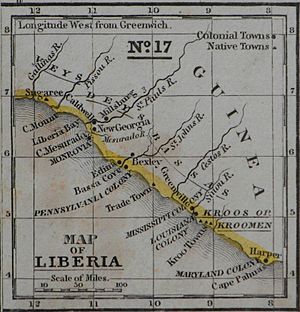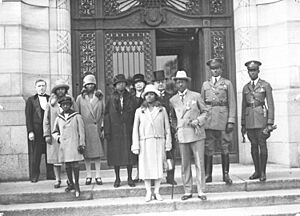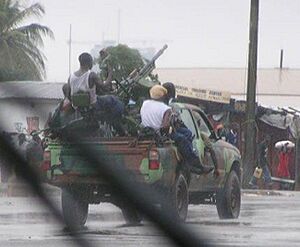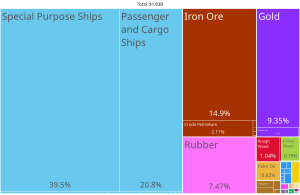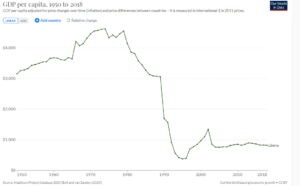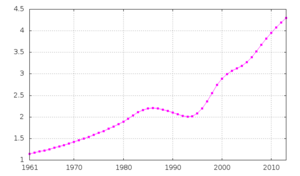Liberia facts for kids
Quick facts for kids
Republic of Liberia
|
|
|---|---|
|
|
|
|
Motto: "The Love of Liberty Brought Us Here"
|
|
|
Anthem: "All Hail, Liberia, Hail!"
|
|

Location of Liberia (dark green)
|
|
| Capital and largest city
|
Monrovia 6°19′N 10°48′W / 6.317°N 10.800°W |
| Official languages | English |
| Ethnic groups
(2008)
|
|
| Religion
(2018)
|
|
| Demonym(s) | Liberian |
| Government | Unitary presidential republic |
| Joseph Boakai | |
| Jeremiah Koung | |
|
• House Speaker
|
Jonathan F. Koffa |
| Legislature | Legislature of Liberia |
| Senate | |
| House of Representatives | |
| Formation and Independence from American Colonization Society | |
|
• American Colonization Society settlement
|
January 7, 1822 |
|
• Independence declared
|
July 26, 1847 |
|
• Republic of Maryland annexed
|
March 18, 1857 |
|
• Recognition by the United States
|
February 5, 1862 |
|
• United Nations membership
|
November 2, 1945 |
|
• Current constitution
|
January 6, 1986 |
| Area | |
|
• Total
|
43,000 sq mi (111,370 km2) (102nd) |
|
• Water (%)
|
13.514 |
| Population | |
|
• 2024 estimate
|
5,437,249 (120th) |
|
• Density
|
92.0/sq mi (35.5/km2) (180th) |
| GDP (PPP) | 2023 estimate |
|
• Total
|
|
|
• Per capita
|
|
| GDP (nominal) | 2023 estimate |
|
• Total
|
|
|
• Per capita
|
|
| Gini (2016) | 35.3 medium |
| HDI (2022) | low · 177th |
| Currency | Liberian dollar (LRD) |
| Time zone | UTC (GMT) |
| Date format | mm/dd/yyyy |
| Driving side | right |
| Calling code | +231 |
| ISO 3166 code | LR |
| Internet TLD | .lr |
|
Website
Executive mansion |
|
The Republic of Liberia is a country located on the coast of West Africa. It shares borders with Sierra Leone, Guinea, and Ivory Coast. Liberia is about 520 kilometres (320 mi) long and 270 kilometres (170 mi) wide. As of 2021, about 5 million people live in Liberia. The capital city is Monrovia. Liberia is also known for being a "flag of convenience" for ships.
Contents
Geography and Environment
Liberia is in Southwest Africa, along the Atlantic Ocean coast. Most of the country has low mountains, usually between 300 metres (980 ft) and 500 metres (1,600 ft) above sea level. The coastal area is swampy and stretches 30 kilometres (19 mi) to 50 kilometres (31 mi) inland. Further in, there is a plateau about 400 metres (1,300 ft) high.
About 60% of Liberia is covered by rainforest. In the north, the mountains are higher. There are also large plantations of rubber trees, which are important for the country's economy. Near the coast, you can find mangrove swamps.
Environmental Challenges
Liberia faces several environmental problems. One big issue is the hunting and eating of endangered animals, known as bushmeat. Some of these animals are also sold to nearby countries. Since much of Liberia is rainforest, Slash-and-burn farming is a problem, as it destroys forests. Illegal logging also harms the environment. In the capital city of Monrovia, there is a lot of pollution.
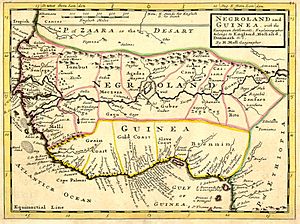
History of Liberia
People have lived in the area now known as Liberia for a very long time, possibly since the Stone Age. Ancient tools found here show that early humans were present. Over time, different groups of people moved into the region.
Early People and Migrations
The Pepper Coast, also called the Grain Coast, has been home to native people since at least the 12th century. Mande-speaking groups moved west from the Sudan region. This pushed many smaller groups, like the Dei, Bassa, Kru, Gola, and Kissi, south towards the Atlantic Ocean.
More people arrived as large empires like the Mali Empire (1375) and the Songhai Empire (1591) declined. As inland areas became drier, people moved to the wetter coast. These new arrivals brought skills like cotton spinning, cloth weaving, iron smelting, and growing rice and sorghum. They also brought new ways of organizing society and government.
People living along the coast used canoes to trade with other West Africans.
European Traders and Colonization
From 1461 to the late 1600s, traders from Portugal, the Netherlands, and Britain set up trading posts in the region. The Portuguese called it Costa da Pimenta ("Pepper Coast") because of the many melegueta pepper grains.
In the United States, there was a movement to send free African Americans to Africa. These people, whether born free or formerly enslaved, faced unfair treatment and discrimination in the U.S. In 1816, the American Colonization Society (ACS) was formed. It included Quakers and slaveholders. Quakers believed black people would have more freedom in Africa. Slaveholders, who did not want enslaved people to be free, saw sending free black people away as a way to prevent slave rebellions.
In 1822, the ACS started sending free African Americans to the Pepper Coast to create a colony. Many people died from tropical diseases. By 1867, the ACS had helped over 13,000 people from the U.S. and the Caribbean move to Liberia. These settlers and their children became known as Americo-Liberians. They often had mixed heritage and were educated in American ways. They saw themselves as different from the native people of the area.
The Americo-Liberian settlers did not get along well with the native people. The native Kru and Grebo groups often attacked the colonial settlements. The Americo-Liberians believed they were better than the native people. They formed an elite group that held all the political power. They copied the style of the American South, wearing fancy clothes and keeping native people from economic chances. They even made native people work on plantations like slaves. Native tribesmen did not become full citizens of their own land until 1904.
Becoming an Independent Nation

On July 26, 1847, the settlers declared their independence and created a constitution. It was based on the U.S. Constitution. This created the independent Republic of Liberia. On August 24, Liberia adopted its 11-striped national flag. The United Kingdom was the first country to recognize Liberia's independence. The United States did not recognize Liberia until 1862.
The new nation was mostly led by Americo-Liberians. They controlled politics and business in the coastal areas. They passed a law in 1865 that stopped foreign trade with inland tribes. This was supposedly to "encourage civilized values" before trade was allowed.
By 1877, the True Whig Party became the most powerful political group. It was mainly made up of Americo-Liberians. They kept social, economic, and political control for a long time, similar to how European colonists acted in other African nations.
Liberia lost some of its land to the United Kingdom (which controlled Sierra Leone) and France (which had interests in the north and east). Liberia also struggled to get money to build roads and develop its economy. In the late 1800s, Liberia's goods production went down, and the government faced financial problems, leading to many international loans.
The 20th Century and World Wars
In the early 1900s, rubber production became a major industry. By 1914, Germany handled three-quarters of Liberia's trade. This worried British and French colonial leaders as tensions with Germany grew.
Liberia stayed neutral during World War I until August 4, 1917, when it declared war on Germany. Liberia was one of 32 nations at the Versailles Peace Conference in 1919, which ended the war. It also helped create the League of Nations.
In 1927, Liberia had an election that was widely seen as unfair. The winning candidate was said to have received more votes than there were eligible voters! After this, reports of forced labor in Liberia led the League of Nations to investigate. The investigation found that the government was involved in widespread "forced labor." Minority ethnic groups were especially exploited. Because of this report, President Charles D. B. King and Vice President Allen N. Yancy resigned.
In the mid-1900s, Liberia began to modernize with help from the United States. During World War II, the U.S. built important structures like the Freeport of Monrovia and Roberts International Airport to help its military efforts.
After the war, President William Tubman encouraged foreign companies to invest in Liberia. In the 1950s, Liberia had the second-highest economic growth rate in the world. Liberia was also a founding member of the United Nations. It spoke out against South African apartheid and supported African countries becoming independent from European rule. Liberia also helped fund the Organisation of African Unity.
Political Changes and Civil Wars
On April 12, 1980, a military coup led by Master Sergeant Samuel Doe took over the government. President William R. Tolbert, Jr. was killed. Doe and his group then executed many of Tolbert's government officials. Doe's group formed the People's Redemption Council (PRC) to rule the country. The U.S. supported Doe with money, but critics said the PRC was corrupt and unfair.
After Liberia adopted a new constitution in 1985, Doe was elected president. However, many people around the world said the election was rigged. In 1985, a failed attempt to overthrow Doe led to more violence. Doe's troops attacked members of the Gio and Mano ethnic groups.
In December 1989, a rebel group called the National Patriotic Front of Liberia (NPFL), led by Charles Taylor, started a fight against Doe's government. This began the First Liberian Civil War. By September 1990, Doe was captured and killed by rebel forces.
The rebels then started fighting among themselves. The Economic Community of West African States Monitoring Group sent a military force to help. From 1989 to 1997, about 60,000 to 80,000 Liberians died. By 1996, about 700,000 people had to leave their homes and go to refugee camps in other countries. A peace deal was made in 1995, and Taylor was elected president in 1997.
Under Taylor's rule, Liberia became known as a "pariah state" (meaning it was not liked by other countries). This was because it used blood diamonds and illegal timber sales to fund rebels in the Sierra Leone Civil War. The Second Liberian Civil War began in 1999 when another rebel group started fighting Taylor.
Liberia in the 21st Century
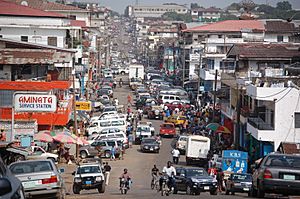
In 2003, a third rebel group began attacking Taylor. Peace talks started in June 2003. Taylor was charged with crimes against humanity by the Special Court for Sierra Leone. By July 2003, rebels attacked Monrovia.
Under pressure from other countries and the Women of Liberia Mass Action for Peace movement, Taylor resigned in August 2003 and went into exile. A peace deal was signed later that month.
The United Nations Mission in Liberia arrived in September 2003 to help keep the peace. An interim government took over in October. The 2005 elections were considered the fairest in Liberia's history. Ellen Johnson Sirleaf, an economist, became the first female president in Africa. She later won the Nobel Peace Prize.
In 2006, the government set up a Truth and Reconciliation Commission to look into the causes and crimes of the civil war. In 2011, another peace activist, Leymah Gbowee, also received the Nobel Peace Prize for her work in ending the civil war.
After the 2017 Liberian general election, former football star George Weah became president on January 22, 2018. This was Liberia's first fully democratic change of power in 74 years. Weah promised to fight corruption, improve the economy, and reduce illiteracy.
Economy

The Central Bank of Liberia prints and manages the Liberian dollar, which is Liberia's main money. Liberia is one of the world's poorer countries. Only about 15% of people have formal jobs. In 2011, Liberia's GDP per person was very low, one of the lowest in the world. Historically, Liberia's economy has relied a lot on foreign aid, money invested by foreign companies, and exports of natural resources like iron ore, rubber, and timber.
Economic Challenges and Growth
After a good period in 1979, Liberia's economy started to decline because of poor management after the 1980 coup. The civil war that began in 1989 made things much worse. The country's GDP dropped by about 90% between 1989 and 1995.
After the war ended in 2003, the economy started to grow again. In 2007, it grew by 9.4%. The global financial crisis in 2008 slowed growth, but a stronger farming sector helped growth increase again.
Today, things that slow down Liberia's economic growth include a small local market, not enough good roads and buildings, high transport costs, and weak trade with nearby countries. Liberia used the United States dollar as its money from 1943 to 1982. It still uses the U.S. dollar alongside the Liberian dollar.
Liberia's external debt (money owed to other countries) was very high in 2006, about $4.5 billion. But thanks to help from other countries and organizations, this debt fell to $222.9 million by 2011.
During the civil war in the 1990s, Liberia became a major trader in blood diamonds from Sierra Leone. This led the United Nations to ban Liberian diamond exports in 2001. The ban was lifted in 2007. In 2003, the UN also put sanctions on Liberian timber exports, which were believed to be funding rebels. These timber sanctions were lifted in 2006.
Liberia has a very high amount of foreign investment compared to its GDP. Since 2006, over $16 billion has been invested. After President Sirleaf took office in 2006, Liberia signed big deals with companies like ArcelorMittal and Sime Darby for iron ore and palm oil. However, some palm oil companies have been accused of harming local communities. Since 1926, Firestone has run the world's largest rubber plantation in Liberia. It is the country's biggest private employer.
Shipping Flag of Convenience
Liberia is known as a "flag of convenience" country. This means that many ships from around the world are registered there, even if they don't operate in Liberia. Liberia has the second-largest maritime registry in the world, after Panama. About 3,500 vessels are registered under Liberia's flag, which is 11% of all ships worldwide.
People and Culture
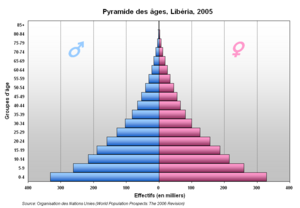
As of the 2017 census, Liberia had 4,694,608 people. Most of them, 1,118,241, live in Montserrado County, where the capital Monrovia is located. Monrovia itself has 970,824 residents.
Liberia's population has grown quickly. In 2010, about 43.5% of Liberians were under the age of 15.
Ethnic Groups
Liberia has 16 main ethnic groups and several foreign minorities. About 95% of the population belongs to one of the indigenous groups. The 16 officially recognized groups include the Kpelle, Bassa, Mano, Gio (or Dan), Kru, Grebo, Krahn, Vai, Gola, Mandingo (or Mandinka), Mende, Kissi, Gbandi, Loma, Dei (or Dewoin), and Belleh.
The Kpelle are the largest ethnic group, making up over 20% of the population. They mostly live in Bong County. Americo-Liberians, who are descendants of African American and West Indian settlers, make up about 2.5% of the population. Another group, called Congo people, are descendants of freed slaves from the Congo River area who arrived in 1825. These two groups held political power for a long time.
Liberia's citizenship rules usually only allow "Negroes or persons of Negro descent" to be citizens. However, many immigrants, like Lebanese and Indians, have come as merchants and are important in business. There are also many mixed-race people, especially in Monrovia, due to marriages between Liberians and Lebanese.
Languages
English is the official language of Liberia and is used for communication between different groups. There are 31 native languages spoken in Liberia, but each is the first language for only a small part of the population. Liberians also speak different creolized dialects known as Liberian English.
Culture

The Americo-Liberians brought their customs and culture from the American South. They wore formal clothes like top hat and tails and built homes like those in the Southern U.S. Many Americo-Liberian men were part of the Masonic Order of Liberia, which was very involved in the country's politics.
Liberia has a rich history in textile arts and quilting. Settlers brought their sewing and quilting skills with them. Liberia held National Fairs in 1857 and 1858, where prizes were given for needlework. A famous Liberian quilter was Martha Ann Ricks, who gave a quilt with a Liberian coffee tree design to Queen Victoria in 1892.
Liberia also has a strong literary tradition that goes back over a century. Important Liberian authors include Edward Wilmot Blyden, Bai T. Moore, Roland T. Dempster, and Wilton G. S. Sankawulo. Moore's book Murder in the Cassava Patch is considered Liberia's most famous novel.
Food and Cuisine
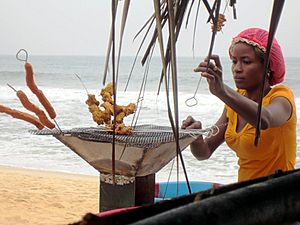
Liberian food often includes rice, which is the country's main food. Other common ingredients are cassava, fish, bananas, citrus fruit, plantains, coconut, okra, and sweet potatoes. Thick stews spiced with hot chilies like habanero and scotch bonnet are popular and eaten with fufu. Liberia also has a unique tradition of baking that came from the United States.
Sports
The most popular sport in Liberia is association football (soccer). Former President George Weah is the nation's most famous athlete. He is the only African player to have won the FIFA World Player of the Year award. The Liberia national football team has played in the Africa Cup of Nations finals twice, in 1996 and 2002.
The second most popular sport is basketball. The Liberian national basketball team has played in the AfroBasket tournament twice, in 1983 and 2007.
The Samuel Kanyon Doe Sports Complex in Liberia is a large stadium used for many events. It hosts FIFA World Cup qualifying matches, international concerts, and national political events.
Images for kids
-
Pygmy hippos are among the species illegally hunted for food in Liberia.
See also
 In Spanish: Liberia para niños
In Spanish: Liberia para niños




